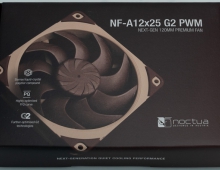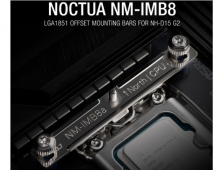Noctua NF-R8 & NF-S12
1. Introduction
 Many users after buying a brand new computer, look for ways to optimize its performance or enhance its appearance. Among those are noise reduction and efficient cooling, two very hot subjects that also occupy many forum threads and produce a variety of articles on thousands of web sites.
Many users after buying a brand new computer, look for ways to optimize its performance or enhance its appearance. Among those are noise reduction and efficient cooling, two very hot subjects that also occupy many forum threads and produce a variety of articles on thousands of web sites.
The Holy Grail for many high end users has been to find a rotating fan with zero noise level and at the same time produce enough airflow to keep the case and its components cool.
The solution for both cases may come from Noctua, an Austrian company that manufactures cooling products for computers. In this review, we are going to examine two of their latest and most silent case fans.
Noctua provided us with their 12cm (NF-S12) and 8cm (NF-R8) case fans. Let's take a look at the specifications of these two fans.

NF-S12 |
NF-R8 |
||||
Normal |
U.L.N.A |
Normal |
L.N.A. |
U.L.N.A. |
|
| Bearing | SSO-Bearing |
SSO-Bearing |
|||
| Blade Geometry | Straight-Blade-Design |
Raised-Blade-Design |
|||
| RPM | 1200 |
600 |
1800 |
1300 |
800 |
| Airflow (m3/h) | 81 |
41 |
53 |
39 |
26 |
| Acoustical Noise (db) | 17 |
< 6 |
17 |
10 |
7 |
| Input Power (Watt) | 1,44 |
1,32 |
|||
| Input Current (A) | 0,12 |
0,11 |
|||
| Voltage Range (Volt) | 4-13 |
4-13 |
|||
| MTBF | >150.000 h |
> 150.000 h |
|||
The fans have sound-optimized blade geometry and profile, developed by the Austrian Institute for Heat-Transmission and Fan Technology, with self-stabilising oil-pressure bearings (SSO bearing) that makes them produce less noise and greater life-span than the traditional ball-bearing fans. The NF-S12 uses Straight Blade Design while the NF-R8 uses Raised-Blade-Design, both patented by Noctua.
- Packaging
Both fans came in retail packaging with Ultra Low Noise Adaptor, 4 silicon vibration compensators, 3:4-pin adaptor and 4 typical fan screws. The NF-R8 also comes with a Low Noise Adaptor. These adaptors (L.N.A. and U.L.N.A.) are simply short power extensions cables (to the right of the box in the picture below), that have a resistor in-line to reduce the current flowing to the fan and hence reduce the fan's rotation speed.























